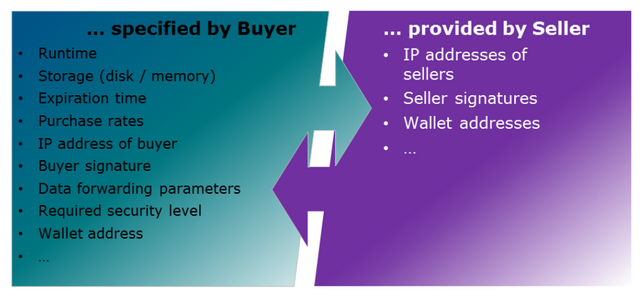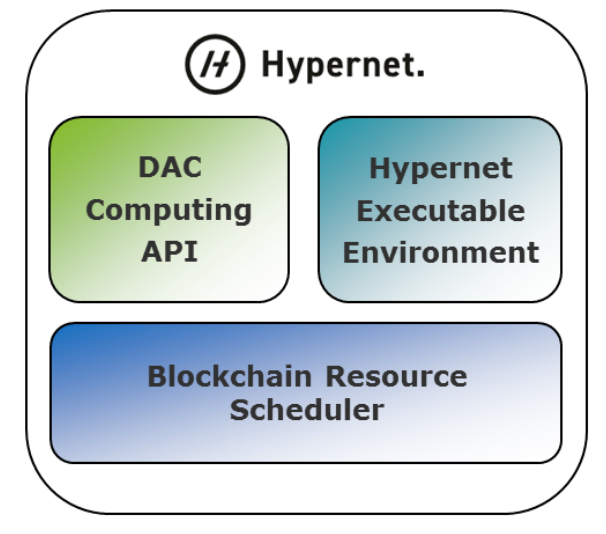ICO Review: Hypernet
What is Hypernet
Hypernet is a decentralized protocol enabling parallel computing from idle computational power. Their goal is similar to familiar projects such as Golem and Sonm. Rather than becoming a “me too” project, Hypernet is betting on a differentiated architecture to achieve truly decentralized, dynamic, and distributed computing. As an investor two questions come to mind:
- Is the technology achievable?
- As a business or as an application, will Hypernet be cheaper, faster, and more secure than centralized cloud computing?
Now that I’ve gotten that rote disclaimer out of the way, let’s dive in.

Token Metrics
I have too many gaps in the information I have but I have heard of a hard cap of $15M. Token supply, distribution, and vesting schedules have not been announced yet. All of the articles and conversations you see floating around are early to this project. YouTube influencers are barely getting their information distributed to them about this project as well.

The Team
The team members below are focused on the technical aspects of Hypernet.

- Ivan Ravlich, CEO: Masters in Aeronautics and Astronautics from Stanford University. Currently on leave for his PhD for Aeronautics and Astronautics.
- Todd Chapman, CTO: Masters and PhD in Aeronautics and Astronautics from Stanford University. A a Department of Defense National Defense Science and Engineering Graduate.
- Daniel Maren, co-founder: Previously co-founded Dragonfly Systems and acquired by SunPower. Previously received Forbes 30 under 30 award. Also a Stanford University alum.
-
Anastasios Angelopoulos, engineer, Stanford alum B.S. EE
- Christopher Hansen, technical lead: B.S. EE and M.S. EE from Stanford Univerity. Short professional stints at Twitter and Facebook on backend and Bluetooth hardware projects. Worked for over a year at NVIDIA on GPU software.

Golem: First Crypto to Tackle Distributed Computation
Let’s start with a project I am already familiar with: Golem. I was an investor in the project as of mid-2017. Golem has unfortuntely suffered project delays but the overall market value of the project has increased since I first became involved. Their original roadmap featured discrete milestones named Brass Golem (CGI rendering), Clay Golem (machine learning, computational chemistry), Stone Golem (third party integrations), and Iron Golem (fully functional). Their approach was to leverage a familiar architecture known as Grid Computing. For those unfamiliar with this architecture, Grid Computing is the collection of computer resources from multiple locations to reach a common goal. In the case of Brass Golem the goal is enable Computer Graphic Interface rendering. In theory, this could make sense to break down high computational costs such as image rendering. Pixar’s Monsters University film took 29 hours to render a single frame. By drawing upon a vast network of idle computing power, Pixar could hypothetically reduce its own hardware overhead using the Golem network.
It has been a year since I first invested in Golem and in my opinion the project has little to show for its effort. That’s not necessarily disappointing given the team’s goal of creating something that has never been done before at scale. Needless to say, it appears Golem’s approach is reaching major hurdles. With distributed architectures, there are two primary unavoidable consequences.
The first is the high amount of network communication and data transfer overhead. The second is the heterogenous nature of distributed networks: hardware is differentiated, capacity per node fluctuates, and node availability comes and goes as computers and servers go offline. This can be solved for in centralized data centers since engineers are familiar with the overall architecture, state, and availability of each machine. With distributed networks, the known state and availability of each machine is unknown. This dynamism can be solved by increasing communication overhead but that will make computations over a distributed network expensive. Additionally, it forces projects such as Golem to focus on specific tasks (rendering) to reduce another layer of overhead. Might as well stick with data centers or Amazon AWS.

Hypernet: Trying a Different Approach
Hypernet plans to take an entirely different approach than adapting existing architectures such as Grid Computing. The project founders believe that many computers do not run at full capacity, that CPU and RAM is sufficient for parallel computing tasks. This idle capacity could be monetized rather than left underutilized. By using token economics, node reputation and staking collateral, Hypernet could be instrumental in enabling a marketplace for computational resources. Buyers (apps or businesses) will have computing requirements in which the seller must prove they have the capability to meet the buyer’s needs. The Hypernet marketplace will be enabled via smart contracts. Their resource scheduler is built on Ethereum smart contracts.

I mentioned CPUs up above to bring up a point of GPU miners. Mining rigs typically utilize their full capacity to solve one specific problem. The type of computing Hypernet aims to achieve is broader than GPU mining and Golem’s focus on rendering. Hypernet’s goal of enabling broader computing is much more ambitious. Golem and SONM focused the tasks they solved, so Hypernet's ambitions may be its largest risk.
Hypernet will provide an API suite to perform parallel data operations. Bandwidth and availability will be managed by the Distributed Average Consensus (DAC). The DAC would presumably dynamically adjust supply even after nodes drop out or experience bandwidth declines to meet the buyer’s needs. Buyers will post a job to the market and that job will be assigned to a Virtual Machine (VM) or a series of VMs. In practice, the buyer would be able to run multiple jobs in parallel on a machine. Once a particular VM completes its task, it can move to the next job even if the job is completely different. Recruiting CPU and GPU capacity at sufficient specifications to match buyer's needs is another risk factor to Hypernetwork. If the incentives do not align properly to bring high end computing resources online, it leaves Hypernetwork to solve lower level computational needs. The billion dollar question lies in how valuable are low level tasks and what is the overall opportunity costs of missing out on high computational tasks.
One of the first tests the team did was fun HN on six different Raspberry Pis to perform a parallel Matrix Multiplication (MMUL). On Raspberry Pis! I am still waiting on the team to reply to me to see their full stack demo. Their GitHub is also currently not public so I will definitely add to this review as they announce when it will be public. Since the project is potentially groundbreaking, I would hope they open source their code base for the general community to innovate further on.

Verdict
We are clearly in an age of experimentation. Projects are trying to push their technology to solve unsolved problems such as distributed computing at scale. Investors are experimenting as well. When, in any era, have retail investors been able to invest at the R&D stage of a project and expect a financial return. As exciting as it is, this arena is fraught with risk. The team is a group of recently graduated or in-flight PhD students from Stanford. As far as raw technology talent, this team is loaded. Just remember the technology may or may not work. I sincerely hope it does work.
Hypernet is in its early stages. I see this project garnering a ton of hype just based on the bare bones team assembled. With a reasonable pre-raise the team could afford to bring on professionals focused on Go-To-Market. ICOs are no longer merely whitepaper projects but require the support of sales, marketing, PR, and legal teams. Publishing a protocol is just not enough anymore.
With that said, I invested in Golem because I wanted to fund the next era of space exploration… I mean distributed computing. I wanted to be a part of the future. I get that same “feeling” with Hypernet. As a former finance professional it pains to use the word “feeling” when it comes to investing. But this is what it is. My numbers based argument should be one that you’re thinking about right now. You might be thinking Golem is a competitor. Were Tesla and Edison competitors in enabling electricity? They were, but they also complemented and pushed each other to bring a product ready for mass consumption. Hypernet and Golem are taking different approaches, as they should. It’s unclear which architecture or if any of these will prevail. Golem has already reached a market cap well over half a billion dollars. That may be a fluffy number so let’s mark this down into the bargain bin at 50%. With Hypernet’s stated hard cap of $15M it’s possible Hypernet will richly reward early speculators. As far as long term technology goes, I sure hope Hypernet figuratively and literally lands us on the moon. The question remains... will Hypernet's computing be faster, cheaper, and more secure than centralized computing. I'm not sure, but I will be personally looking to participate in this project. With such a small cap, an intelligent team, and a speculators market I will be rolling the dice.

Sources
- The Economics of the Golem Token
- Wikipedia, Grid Computing
- How Pixar Made Monsters University
- How Hypernet compares to Golem, Sonm, iExec
- Matrix Multiplication: Distributed Algorithm

Thank you for coming to the site. Quantalysus publishes blockchain research and analysis for the crypto community. Please follow on Twitter, Steem (please follow and upvote if you can – thanks!), Telegram channel (New!), and Medium to stay up to date.
If you want to earn Aelf (ELF) tokens for just using Twitter and Reddit, sign up for their candy / bounty program.
If you learned something:
- Please consider donating to keep this website up and running
- Earn Aelf tokens by following them on Twitter (my referral link)
- Follow me on Steem (@quantalysus). I appreciate upvotes!
- Follow me on Twitter (@CryptoQuantalys)
- Education Series: Why we need Bitcoin
- Education Series: The History of Bitcoin
- Education Series: Airdrops
- Education Series: Byzantine General’s Problem
- Education Series: Regulation A and D
- ICO Review: Lightstreams
- ICO Review: Hero Node
- ICO Review: Solana
- ICO Review: Phantasma
- ICO Review: Holochain
- ICO Review: Edenchain
- ICO Review: Quarkchain
- ICO Review: DAOStack
- ICO Review: Alchemint
- ICO Review: Loki Network
- Coin Review: Nexo
- Coin Review: Ontology
- Coin Review: Aelf
- Coin Review: Mithril
- Coin Review: Qtum
- Coin Review: Waves
- Coin Review: Banyan Network (BBN)
- Opinion: Token economics
- Opinion: ICO paradox
- Opinion: Why we love Steem
- Analysis: If Steem were a country, it would be the most unequal society

Hypernet is seems to be future most famous protocol in the field of cryptocurrencies and blockchain. Special thanks for sharing your research and analysis with us. @quantalysus
It won't be easy but I guess it's achievable. The crypto future is bright so let's hope for the best of the incoming projects!
Thanks for reading
thanks for sharing the knowledge, that's a solid overview. tipuvote! 0.5
Thanks for reading. :)
I had recently the chance to talk to Mike Maples at an event in Punta Mita and he introduce me to the concept of the Hypernet. At his blog with Roger McNamee I found the short response and I would like to share to try to expand such an important concept for future innovation.
"Hypernet: the physical infrastructure that results from combining the internet with cellular and wifi. At present half the nodes are computers and half are smart phones, but the balance is moving away from computers."
Thanks @brianmack. Agree that we are moving towards lower consumption devices such as tablets and mobile phones. I'm worried about not having enough supply of higher level compute resources for high level tasks.
can't keep up with all these explorations. It doesn't end. The blockchain is just endless!!!
Seriously. I know how you feel lol. I try to write about 2 projects a week and I find myself having to select from a buffet of options. Hopefully my articles help highly a few good ones throughout the year.
Very interesting ... new technologies are increasingly surprising us. The future users that we look for, economy and efficiency, and we are open to new projects like Hypernet. We will continue informing, it seems very interesting.
Thanks for reading.
Thanks for the post I'm gonna look into it.
I think it'll do well as far as speculation goes.
Hi @quantalysus! You have received 0.5 SBD @tipU upvote from @cardboard !
from @cardboard !
@tipU pays 100% profit + 50% curation rewards to all investors, allows to automatically reinvest selected part of your payout and can do other cool stuff :) Click here for more info.
I'm just looking to establish a position in the Steemit community, and would appreciate to find some people like me, so we can mutually support one another. subscribe @khaled4444